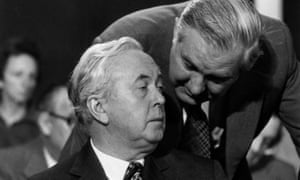
Harold Wilson with James Callaghan at the Labour party conference in Blackpool in 1975. Photograph: Frank Barratt/Getty Images
Britain’s recent jobs record has been remarkable. The economy is chugging along but the last time the unemployment rate was as low as it is today was in the winter of 1974-75. Harold Wilson was prime minister, Derby County were on course to win the old first division, David Bowie was about to release Young Americans.
Back then things were about to take a turn for the worse. Prices were rising fast, and later in 1975 inflation would hit a postwar peak of more than 25%. Unemployment also rose, leading to the coining of a new term – stagflation. In 1976, there was the mother and father of a sterling crisis that ended with spending cuts being imposed by the International Monetary Fund.
The 1970s are still seen as the fright decade, even though they are as distant in time for today’s young adults as the early 1930s were for those who came of age when Wilson became prime minister for a second time in 1974. A regular barb aimed at Jeremy Corbyn is that he wants to return Britain to the “dark days” of the 1970s.
In some ways, attempts to draw comparisons between now and the 1970s are ridiculous. The lights have not gone out. Industry has not been put on a three-day week. Ministers no longer live in fear of the National Union of Mineworkers. An unemployment rate of 3.9% sits alongside an inflation rate below 2%, not one heading for 20%-plus. Those were the days before mobile phones and social media. Bowie fans didn’t stream Young Americans; they bought it on vinyl.
Continue reading
No comments:
Post a Comment